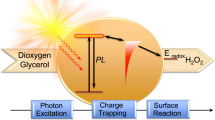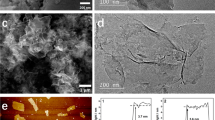Abstract
Photon-driven chemical processes are usually mediated by oxides, nitrides and sulfides whose photo-conversion efficiency is limited by charge carrier recombination. Here we show that lithium hydride undergoes photolysis upon ultraviolet illumination to yield long-lived photon-generated electrons residing in hydrogen vacancies, known as F centres. We demonstrate that photon-driven dehydrogenation and dark rehydrogenation over lithium hydride can be fulfilled reversibly at room temperature, which is about 600 K lower than the corresponding thermal process. As light-driven F centre generation could provide an alternative approach to charge carrier separation to favour chemical transformations that are kinetically or thermodynamically challenging, we show that light-activated lithium hydride cleaves the N≡N triple bond to form a N–H bond under mild conditions. Co-feeding a N2/H2 mixture with low H2 partial pressure leads to photocatalytic ammonia formation at near ambient conditions. This work provides insights into the development of advanced materials and processes for light harvesting and conversion.

This is a preview of subscription content, access via your institution
Access options
Access Nature and 54 other Nature Portfolio journals
Get Nature+, our best-value online-access subscription
$29.99 / 30 days
cancel any time
Subscribe to this journal
Receive 12 print issues and online access
$259.00 per year
only $21.58 per issue
Buy this article
- Purchase on Springer Link
- Instant access to full article PDF
Prices may be subject to local taxes which are calculated during checkout




Similar content being viewed by others
Data availability
The data supporting the findings of this study are available within the Article and its Supplementary Information or from the corresponding authors upon reasonable request. The atomic coordinates of the optimized electronic structures are available in the Supplementary Information. Source data are provided with this paper.
References
Wang, H. et al. Semiconductor heterojunction photocatalysts: design, construction, and photocatalytic performances. Chem. Soc. Rev. 43, 5234–5244 (2014).
Schiffer, Z. J. & Manthiram, K. Electrification and decarbonization of the chemical industry. Joule 1, 10–14 (2017).
Chen, J. G. et al. Beyond fossil fuel driven nitrogen transformations. Science 360, eaar6611 (2018).
Hargreaves, J. S. J. et al. Minimizing energy demand and environmental impact for sustainable NH3 and H2O2 production—a perspective on contributions from thermal, electro-, and photo-catalysis. Appl. Catal. A Gen. 594, 117419 (2020).
Lewis, N. S. Research opportunities to advance solar energy utilization. Science 351, aad1920 (2016).
Comer, B. M. et al. Prospects and challenges for solar fertilizers. Joule 3, 1578–1605 (2019).
Jing, L., Zhou, W., Tian, G. & Fu, H. Surface tuning for oxide-based nanomaterials as efficient photocatalysts. Chem. Soc. Rev. 42, 9509–9549 (2013).
Schneider, J. et al. Understanding TiO2 photocatalysis: mechanisms and materials. Chem. Rev. 114, 9919–9986 (2014).
Riente, P. & Noël, T. Application of metal oxide semiconductors in light-driven organic transformations. Catal. Sci. Technol. 9, 5186–5232 (2019).
Banerjee, A. et al. Photochemical nitrogen conversion to ammonia in ambient conditions with FeMoS-chalcogels. J. Am. Chem. Soc. 137, 2030–2034 (2015).
Li, Q., Li, X., Wageh, S., Al-Ghamdi, A. A. & Yu, J. CdS/graphene nanocomposite photocatalysts. Adv. Energy Mater. 5, 1500010 (2015).
Li, Z., Meng, X. & Zhang, Z. Recent development on MoS2-based photocatalysis: a review. J. Photochem. Photobiol. C Photochem. Rev. 35, 39–55 (2018).
Zheng, J. et al. Fe on molecular-layer MoS2 as inorganic Fe-S2-Mo motifs for light-driven nitrogen fixation to ammonia at elevated temperatures. Chem Catal. 1, 162–182 (2021).
Liu, J. et al. Metal-free efficient photocatalyst for stable visible water splitting via a two-electron pathway. Science 347, 970–974 (2015).
Zakutayev, A. Design of nitride semiconductors for solar energy conversion. J. Mater. Chem. A 4, 6742–6754 (2016).
Wang, H., Zhang, X. & Xie, Y. Photoresponsive polymeric carbon nitride-based materials: design and application. Mater. Today 23, 72–86 (2019).
Baldi, A. & Dam, B. Thin film metal hydrides for hydrogen storage applications. J. Mater. Chem. 21, 4021–4026 (2011).
Zhang, W. et al. Deforming lanthanum trihydride for superionic conduction. Nature 616, 73–76 (2023).
Wiedner, E. S. et al. Thermodynamic hydricity of transition metal hydrides. Chem. Rev. 116, 8655–8692 (2016).
Wang, Q., Guo, J. & Chen, P. The power of hydrides. Joule 4, 705–709 (2020).
Bannenberg, L. J., Boelsma, C., Asano, K., Schreuders, H. & Dam, B. Metal hydride based optical hydrogen sensors. J. Phys. Soc. Jpn 89, 051003 (2020).
Dougherty, D. & Herley, P. Photodecomposition kinetics of alkaline earth hydride powders. J. Less Common Met. 73, 97–104 (1980).
Doyle, W., Ingram, D. & Smith, M. Detection of colloidal centers in lithium hydride by electron resonance. Phys. Rev. Lett. 2, 497–499 (1959).
Zhang, X. et al. Solar-driven reversible hydrogen storage. Adv. Mater. 35, 2206946 (2023).
Sun, Y. & Aguey-Zinsou, K. F. Light-activated hydrogen storage in Mg, LiH and NaAlH4. ChemPlusChem 83, 904–908 (2018).
Gao, W. et al. Production of ammonia via a chemical looping process based on metal imides as nitrogen carriers. Nat. Energy 3, 1067–1075 (2018).
Guan, Y. et al. Transition-metal-free barium hydride mediates dinitrogen fixation and ammonia synthesis. Angew. Chem. Int. Ed. 61, e202205805 (2022).
Lewis, W. B. & Pretzel, F. Properties of lithium hydride—III. Paramagnetic resonance of color centers. J. Phys. Chem. Solids 19, 139–146 (1961).
Atkins, P. & Overton, T. Shriver and Atkins’ Inorganic Chemistry (Oxford Univ. Press, 2010).
Luo, Y.-R. Comprehensive Handbook of Chemical Bond Energies (CRC Press, 2007).
Grochala, W. & Edwards, P. P. Thermal decomposition of the non-interstitial hydrides for the storage and production of hydrogen. Chem. Rev. 104, 1283–1316 (2004).
Von Colbe, J. B. et al. Application of hydrides in hydrogen storage and compression: achievements, outlook and perspectives. Int. J. Hydrog. Energy 44, 7780–7808 (2019).
Hirscher, M. et al. Materials for hydrogen-based energy storage – past, recent progress and future outlook. J. Alloy. Compd. 827, 153548 (2020).
Allendorf, M. D. et al. Challenges to developing materials for the transport and storage of hydrogen. Nat. Chem. 14, 1214–1223 (2022).
Zhu, J., Wang, H., Liu, J., Ouyang, L. & Zhu, M. Achieving high dehydrogenation kinetics and reversibility of LiBH4 by adding nanoporous h-BN to destabilize LiH. J. Phys. Chem. C 122, 23336–23344 (2018).
Simpson, F. B. & Burris, R. H. A nitrogen pressure of 50 atmospheres does not prevent evolution of hydrogen by nitrogenase. Science 224, 1095–1097 (1984).
Li, H., Shang, J., Ai, Z. & Zhang, L. Efficient visible light nitrogen fixation with BiOBr nanosheets of oxygen vacancies on the exposed {001} facets. J. Am. Chem. Soc. 137, 6393–6399 (2015).
Brown, K. A. et al. Light-driven dinitrogen reduction catalyzed by a CdS: nitrogenase MoFe protein biohybrid. Science 352, 448–450 (2016).
Medford, A. J. & Hatzell, M. C. Photon-driven nitrogen fixation: current progress, thermodynamic considerations, and future outlook. ACS Catal. 7, 2624–2643 (2017).
Li, L. et al. Nitrogen photofixation over III-nitride nanowires assisted by ruthenium clusters of low atomicity. Angew. Chem. Int. Ed. 56, 8701–8705 (2017).
Hirakawa, H., Hashimoto, M., Shiraishi, Y. & Hirai, T. Photocatalytic conversion of nitrogen to ammonia with water on surface oxygen vacancies of titanium dioxide. J. Am. Chem. Soc. 139, 10929–10936 (2017).
Yin, H. et al. Dual active centers bridged by oxygen vacancies of ruthenium single-atom hybrids supported on molybdenum oxide for photocatalytic ammonia synthesis. Angew. Chem. Int. Ed. 61, e202114242 (2022).
Xin, Y. et al. Atomic-level insights into the activation of nitrogen via hydrogen-bond interaction toward nitrogen photofixation. Chem 7, 2118–2136 (2021).
Linde, G. & Juza, R. IR-spektren von amiden und imiden zwei- und dreiwertiger metalle. Z. Anorg. Allg. Chem. 409, 199–214 (1974).
Cornelius, S. et al. Oxyhydride nature of rare-earth-based photochromic thin films. J. Phys. Chem. Lett. 10, 1342–1348 (2019).
Weatherburn, M. W. Phenol-hypochlorite reaction for determination of ammonia. Anal. Chem. 39, 971–974 (1967).
Li, L. et al. Two-dimensional mosaic bismuth nanosheets for highly selective ambient electrocatalytic nitrogen reduction. ACS Catal. 9, 2902–2908 (2019).
Wang, Q. et al. Ternary ruthenium complex hydrides for ammonia synthesis via the associative mechanism. Nat. Catal. 4, 959–967 (2021).
Hohenberg, P. & Kohn, W. Inhomogeneous electron gas. Phys. Rev. 136, B864–B871 (1964).
Kohn, W. & Sham, L. J. Self-consistent equations including exchange and correlation effects. Phys. Rev. 140, A1133–A1138 (1965).
Kresse, G. & Furthmüller, J. Efficient iterative schemes for ab initio total-energy calculations using a plane-wave basis set. Phys. Rev. B 54, 11169–11186 (1996).
Blöchl, P. E. Projector augmented-wave method. Phys. Rev. B 50, 17953–17979 (1994).
Perdew, J. P., Burke, K. & Ernzerhof, M. Generalized gradient approximation made simple. Phys. Rev. Lett. 77, 3865–3868 (1996).
Kresse, G. & Furthmüller, J. Efficiency of ab-initio total energy calculations for metals and semiconductors using a plane-wave basis set. Comput. Mater. Sci. 6, 15–50 (1996).
Grimme, S. Semiempirical GGA-type density functional constructed with a long-range dispersion correction. J. Comput. Chem. 27, 1787–1799 (2006).
Acknowledgements
We thank F. X. Zhang for beneficial discussions. P.C. and J.G. are grateful for financial support from the National Key R&D Program of China (2021YFB4000400), National Natural Science Foundation of China (grant nos 21988101 and 21922205), Youth Innovation Promotion Association of the Chinese Academy of Sciences (nos Y2022060 and 2022180) and Liaoning Revitalization Talents Program (nos XLYC2007173 and XLYC2002076).
Author information
Authors and Affiliations
Contributions
P.C. and J.G. conceived the project. P.C. and J.G. co-supervised the research and wrote the paper. Y.G. conducted most of the experimental work and prepared the original draught. H.W. conducted the DFT calculations and co-prepared the draught. K.C. and Q.W. assisted with materials synthesis. Z.L. and T.H. reviewed and edited the paper. All authors participated in the discussion and data analyses.
Corresponding authors
Ethics declarations
Competing interests
The authors declare no competing interests.
Peer review
Peer review information
Nature Chemistry thanks Jing Ma and the other, anonymous, reviewer(s) for their contribution to the peer review of this work.
Additional information
Publisher’s note Springer Nature remains neutral with regard to jurisdictional claims in published maps and institutional affiliations.
Extended data
Extended Data Fig. 1 Schematics for charge carrier separation processes.
a, The electron-hole separation and recombination in conventional metal oxide or nitride photocatalysts. b, The electron-hole separation during the photolysis of LiH to form F center and H2.
Extended Data Fig. 2 FT-IR spectra of LiH samples after photo-driven N2 fixation.
LiH samples were treated under different conditions (LiH in 5 bar 14N2 pressure after illumination for 0.5 h-orange, LiH in 5 bar 15N2 pressure after illumination for 0.5 h-blue).
Extended Data Fig. 3 Measurements of NH3 synthesis rates using 1H-NMR spectroscopy.
a, 1H-NMR spectra of 14NH4Cl and 15NH4Cl solutions in the concentration range of 0.1 to 1.0 mM (with equimolar concentrations of 14NH4+ and 15NH4+). b, Linear calibration curves for both 14NH4+ and 15NH4+ derived from 1H-NMR. c and d are the 1H-NMR spectra of 14NH4+ and 15NH4+ signals of the sulfuric acid solutions which absorbed the outlet gas with different sample loadings and different illumination time. e, The corresponding fixed 14N and 15N amounts derived from the 1H-NMR and conductivity meter measurement. f, The corresponding 14N and 15N fixation rates derived from the 1H-NMR. Measurement conditions: LiH dispersed in cyclohexane, N2 pressure, 5 bar; light intensity, 398.2 mW/cm2.
Supplementary information
Supplementary Information
Supplementary Figs. 1–22, Tables 1 and 2, refs. 1–3 and the atomic coordinates of the states in Fig. 3g.
Source data
Source Data Fig. 1
Statistical source data.
Source Data Fig. 2
Statistical source data.
Source Data Fig. 3
Statistical source data.
Source Data Fig. 4
Statistical source data.
Source Data Extended Data Fig. 2
Statistical source data.
Source Data Extended Data Fig. 3
Statistical source data.
Rights and permissions
Springer Nature or its licensor (e.g. a society or other partner) holds exclusive rights to this article under a publishing agreement with the author(s) or other rightsholder(s); author self-archiving of the accepted manuscript version of this article is solely governed by the terms of such publishing agreement and applicable law.
About this article
Cite this article
Guan, Y., Wen, H., Cui, K. et al. Light-driven ammonia synthesis under mild conditions using lithium hydride. Nat. Chem. 16, 373–379 (2024). https://doi.org/10.1038/s41557-023-01395-8
Received:
Accepted:
Published:
Issue Date:
DOI: https://doi.org/10.1038/s41557-023-01395-8



